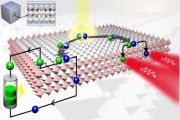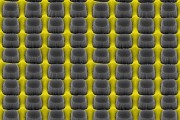 2017-03-14
2017-03-14
In the eternal search for next generation high-efficiency solar cells and LEDs, scientists at Los Alamos National Laboratory and their partners are creating innovative 2D layered hybrid perovskites that allow greater freedom in designing and fabricating efficient optoelectronic devices. Industrial and consumer applications could include low cost solar cells, LEDs, laser diodes, detectors, and other nano-optoelectronic devices.
Continue reading →
 2015-12-11
2015-12-11
Light and electricity dance a complicated tango in devices like LEDs, solar cells and sensors. A new anti-reflection coating developed by engineers at the University of Illinois at Urbana Champaign, in collaboration with researchers at the University of Massachusetts at Lowell, lets light through without hampering the flow of electricity, a step that could increase efficiency in such devices.
Continue reading →
 2014-07-10
2014-07-10
Sandia National Laboratories has come up with an inexpensive way to synthesize titanium-dioxide nanoparticles and is seeking partners who can demonstrate the process at industrial scale for everything from solar cells to light-emitting diodes (LEDs).
Continue reading →
2014-04-14
NTNU researchers Dheeraj Dasa and Helge Weman have, in cooperation with IBM, discovered that gallium arsenide can be tuned with a small strain to function efficiently as a single light-emitting diode or a photodetector. This is facilitated by the special hexagonal crystal structure, referred to as wurtzite, which the NTNU researchers have succeeded in growing in the MBE lab at NTNU. The results were published in Nature Communications this week.
Continue reading →
2010-08-12
TSMC recently held a meeting of the Board of Directors, which passed the following resolutions:
1. Approved capital appropriations of US$1,972.3 million to expand advanced process technology capacity at 12-inch fabs.
2. Approved capital appropriations of US$369 million to continue construction of Fab 15.
3. Approved capital appropriations of US$258.1 million to provide specialty technology capacity.
Continue reading →
 2017-03-14
2017-03-14
 2015-12-11
2015-12-11
 2014-07-10
2014-07-10